This piece was also published on Medium.
For decades, Americans were evenly divided in their relative support of labor unions and big business, but that’s no longer the case. Now, Americans are more likely to side with labor than at any time in the past 60 years. For people whose instincts about economic and political conflicts between unions and big business were honed more than a decade ago, it’s time to update your understanding.
According to newly released American National Election Studies (ANES) data from late 2024, analyzed and reported here for the first time, Americans feel more positively toward labor unions and more negatively toward big business than any time since ANES began asking the question in 1964. Using consistent methods to allow comparability over time, ANES uses representative samples of Americans and asks them to rate their feelings toward labor unions and big business on a 0–100 scale.
Trends broke after 2012
Between 1964 and 2012, Americans’ sentiments toward labor unions and big business moved together, surging and dipping in tandem. The figure below shows how average feelings toward each group changed over time. For instance, during mid-1970s stagflation, Americans cooled to both unions and big business.
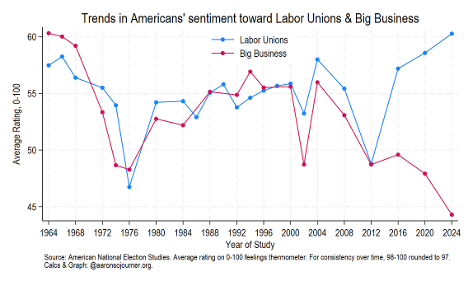
In 2016, Americans’ sentiments toward labor and business split. Feelings toward big business stayed flat while feelings toward labor unions warmed to nearly a record high. In 2020, warmth toward labor unions kept climbing to a record high while sentiment toward big business fell to a record low.
Just-released data from late 2024 reveal that warmth toward labor unions climbed even higher while sentiment to big business fell even further, setting new records for warmth to labor unions and coolness to big business.
A simple way to summarize this is to compute the sentiment difference between labor and big business for each individual who answers both questions. If the person rates both labor and business the same, this difference equals zero. If they rate labor 70 and business 30, the difference equals 40. The more positive the difference, the more pro-union the person is relative to big business. A negative difference expresses more pro-business than pro-labor sentiment.
The trend in the average sentiment difference illustrates just how unprecedented the current situation is. Labor unions have huge sympathy from Americans relative to big business right now, far more than any time on record. The largest gap between 1964 and 2012 was about +5 pro-union in 1974. Now, we are at +16.
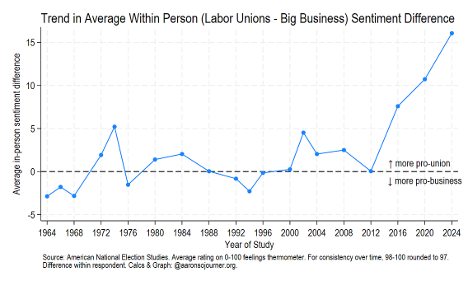
Digging deeper
Looking at subgroups where the changes are bigger and smaller can offer insight into what might be driving this recent change. While Gallup has published similar high-level trends on unions and major corporations over the years, the ANES data enable analysis by subgroup. Also, the ANES survey is more recent than the latest Gallup ones.
The changes for men and for women are similar. This change is not driven by differential attitude changes by gender.
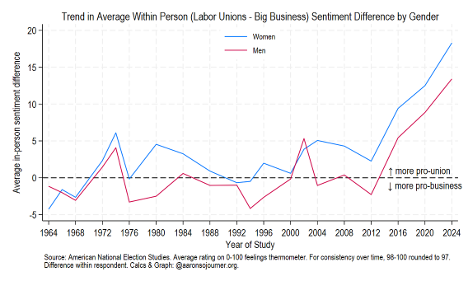
In contrast, recent trends do differ by education group. Until 2012, Americans with the most formal education (Bachelor+) were the most pro-business. By 2024, they became the most pro-union. On the other hand, Americans with the least formal education (less than high school) were historically among the most pro-union but recently became the least pro-union. High school graduates, some college, and bachelor-plus all expressed record-high pro-union sentiment in 2024. Even those without a high school degree remained near their record high.
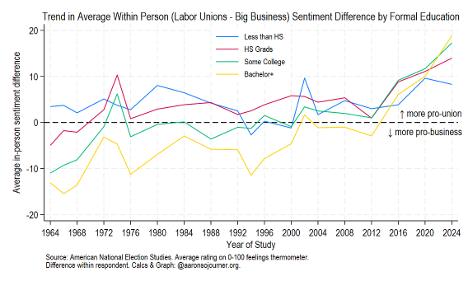
People who identify with different political ideologies experienced similar changes since 2012. Liberals, conservative, moderates, and “don’t knows” are more pro-union than ever.
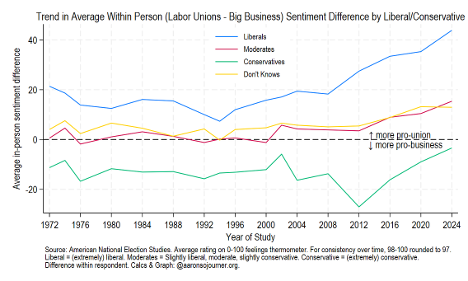
Pro-union shifts occurred among both union members and nonunion workers, stronger among nonunion.
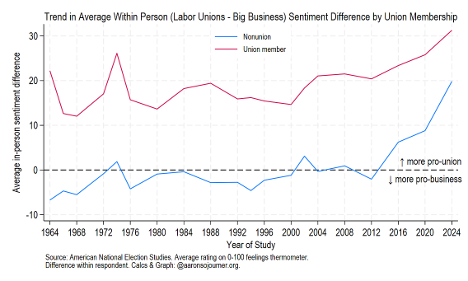
Different race and ethnic groups had similar trends, with all groups becoming more pro-union in rough parallel since 2012.

Between 2012 and 2024, sentiment moved most in a pro-union direction in Alaska, Delaware, and Vermont, with average difference shifts over 40 points pro-union in each of these states. Substantial increases also occurred in some surprising places, in the South (Tennessee, Mississippi, and Louisiana) and in the Southwest and Mountain West (Arizona, Colorado, and Utah). Sentiment became more pro-business only in Wyoming and Montana.
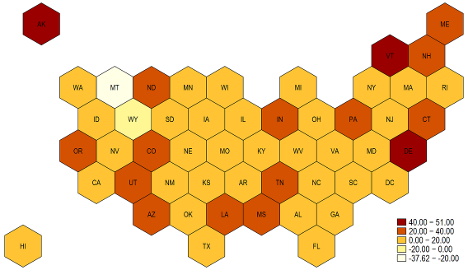
There are several possible explanations for the public’s increasing support for unions. First, broad campaigns by low-wage worker organizations such as the Fight for $15, Starbucks Workers United, and Amazon Labor Union have become increasingly visible. Second, populist politics surged in Bernie Sanders’s presidential campaigns and the rise of “the Squad” in Congress. President Trump sought to soften the GOP’s conventional labor policy agenda with labor-friendly rhetoric during his first term and 2024 campaign. Then-President Biden’s clear pro-union positions made union support more prominent inside the Democratic coalition. Third, wealth concentration and dissatisfaction with it has continued to rise. Fourth, some bosses’ reactions to the pandemic — layoffs and forcing workers to take on more risks—made clear to many Americans that their boss would use power against them. This seems to have left Americans looking for more control over their job and working conditions.
The rise in public sympathy has not yet translated into a higher share of workers forming unions. While an increasing share of nonunion workers want a union in their workplace, unlawful management opposition to workers’ organizing campaigns remains fierce.
The National Labor Relations Act treats white-collar, strategic, and repeat violators of U.S. workers’ rights the way we treat children who stole something for the first time, requiring them only to give back what they took and say they are sorry. The law, written 90 years ago, provides no possibility of fines or penalties—only back pay—and so provides little incentive for compliance.
Regardless of the cause of the split, in fights between organized labor and organized capital, Americans are likely to support labor more now than any time on record.
About the authors: Sojourner is a labor economist at the W.E. Upjohn Institute for Employment Research. Reich is a professor of sociology at Columbia University and co-director of the Columbia Labor Lab.
Sign up for EPI's newsletter so you never miss our research and insights on ways to make the economy work better for everyone.
.png)


